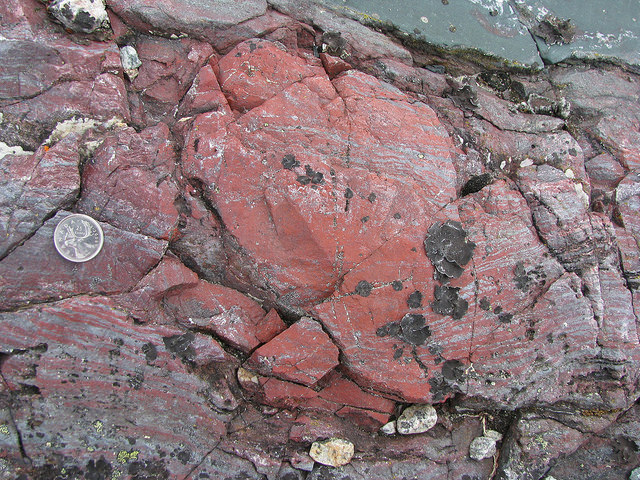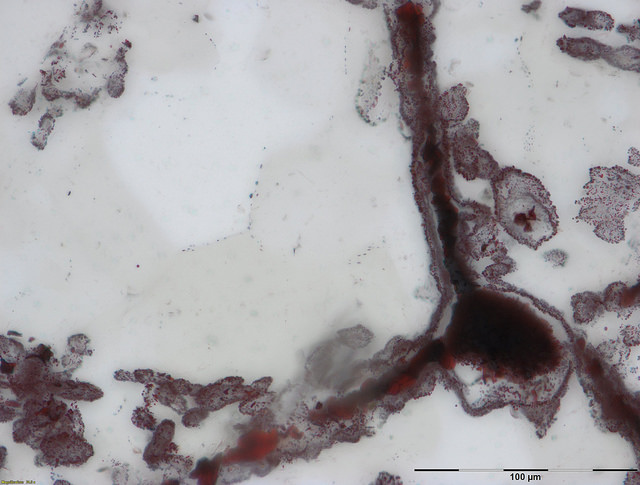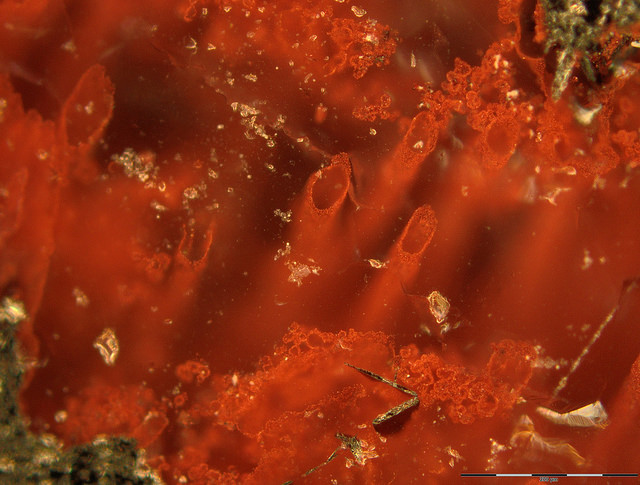Canada may be celebrating its 150th anniversary, but in the grand scheme of the planet, it's still a relatively young nation. Japan and China were started well over 2,000 years ago.
Still, there is one category where this country truly is a grandaddy of the world: the age of its rocks. Two of the four oldest rocks on the planet are found in Canada (the other two are in Greenland and Western Australia). These are the Acasta Gneiss in the Northwest Territories, and the Nuvvuagittuq Greenstone Belt in Northern Quebec. You might think that if you were looking for the oldest evidence of life on Earth, you would look in one of these places.
And you'd be right, too! Because a team of international scientists have just confirmed that the earliest fossils of life have been found in the Nuvvuagittuq Greenstone Belt. Their age? 3.8 billion years.
Long before the dinosaurs

"Can you spare a fossil?" Next to a quarter, you can see the tiny section of rock that scientists have been examining. (Dominic Papineau)
We like to talk about how prehistoric creatures like the dinosaurs lived long, long ago. But compared to these fossils, it's almost as though your average dino was alive only yesterday. Come again?
Dinosaurs last lived about 66 million years ago. These fossils are over 50 times older than that! What's more, they are far closer to the birth of our solar system than the present day. Scientists estimate that the Sun and its planets began forming around 4.6 billion years ago. If that is true, these fossils would've been made when Earth was less than a billion years old. Relatively speaking, if the Earth was a person, it would've only been about 7 years old at the time!
Tiny, tiny, tiny

"I know you're in there somewhere!" Even under a microscope, these fossils are tiny. (Matthew Dodd)
Of course, when it comes to size, dinosaurs are the winners, hands down. The fossils found in Quebec are of microscopic creatures (they are known as microfossils). They are less than half the width of a human hair. That's tiny! Today they are seen as tiny tubes of hematite, a type of iron oxide similar to rust.
In other words, we're not talking about recognizable bones that we normally think of as "fossils". But after testing the rock, the team of scientists from University College London, the Geological Survey of Norway, US Geological Survey, the University of Ottawa and more, are convinced that these were once living things.
On other planets, too?
Scientists believe that Mars once had water on its surface. Do rocks like this contain similar microfossils for us to discover? (Getty Embed/NASA)
Maybe the most thrilling thing in all of this is that studying these fossils can help scientists look for traces of life elsewhere through the solar system (and beyond). That's because these microfossils date from a time when Earth had far less oxygen in its atmosphere than it does today. In fact, it is believed that these creatures ate and breathed iron particles that flowed through underwater thermal vents (or very hot holes in the ocean floor). If life could exist in these conditions, where else might it have existed?
Using fossils like this as clues, scientists will know better what to look for as they examine moons and planets in the future.
Listen to some of the leading researchers explain what they found in Quebec in this video.
 These tiny tubes are microfossils that are the earliest known life on Earth. (Matthew Dodd)
These tiny tubes are microfossils that are the earliest known life on Earth. (Matthew Dodd)










😯 Wow! That is truly fascinating! 😯 😯 😯
neat!
Great want to know more (like they say how could you know your future if you don”t know your past )